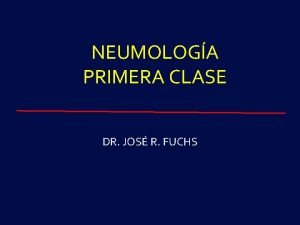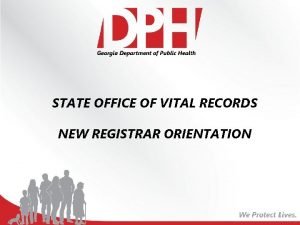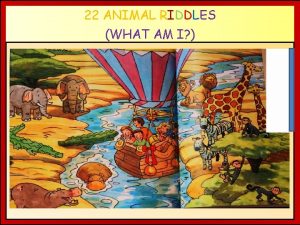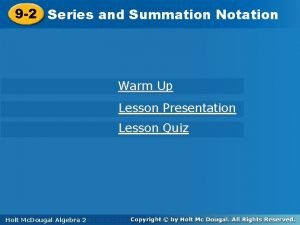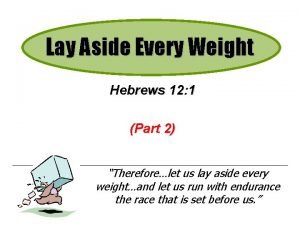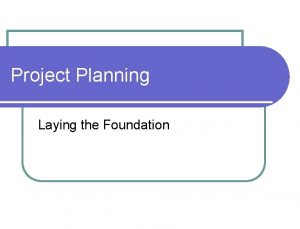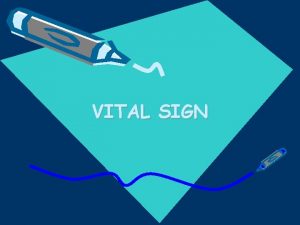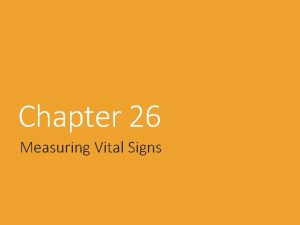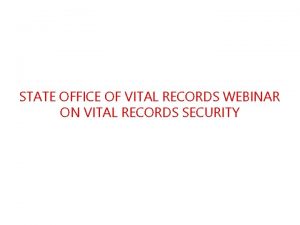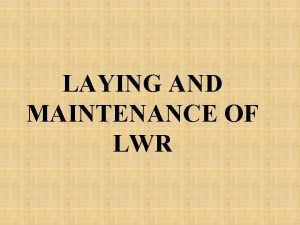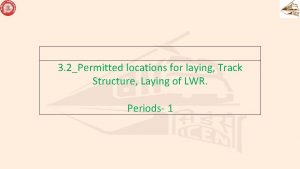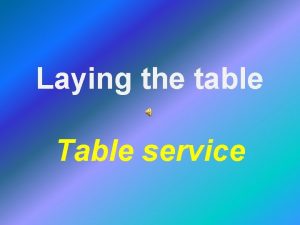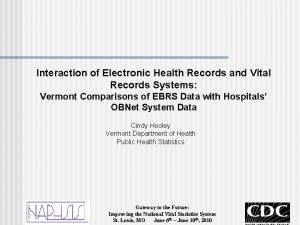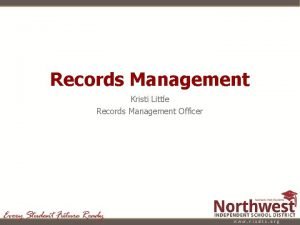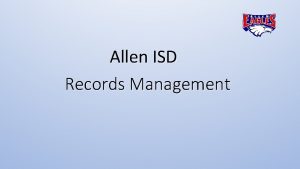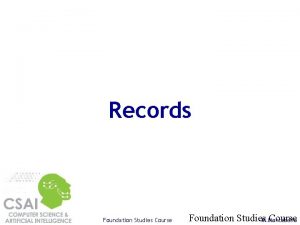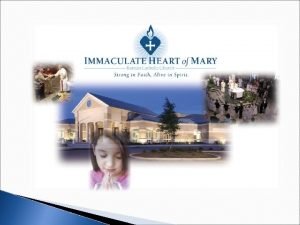Laying the Foundation for Vital Records Standards VSCP






























- Slides: 30

Laying the Foundation for Vital Records Standards VSCP Project Directors’ Annual Meeting May 13, 2008 Hetty Khan, RN, MS, MGA Michelle Williamson, RN, MS Health Informatics Specialists CDC/National Center for Health Statistics

Topics • Overview of VR Landscape • NCHS Standards Initiatives • HL 7 Vital Records Domain Analysis Model • HL 7 EHR-S Vital Records Functional Profile

Current Vital Records Landscape • A significant number of data items on birth and death certificates are captured in medical records • Facility Worksheet: o Contains 41 major categories of data collection about the birth event and fetal death o 36 of these data items can be collected from the medical records of the mother or child

Proposed Future VR Landscape Capturing VR Data at the Point of Care or Contact Registrar Department of Health Electronic Medical Record

Laying the Foundation Debates abound about the: • Use of EHRs as a source for VR information • Benefits of EHR approach to VR community • Improvements in quality and timeliness of VR data • Reductions in the redundancy of data captured

Laying the Foundation It is worthwhile to lay the foundation for standardizing transmission of birth and death events as efforts towards developing and implementing EHRs continues

Building with Data Standards Essential Building Blocks of Information Systems • • • Classification Systems and Terminologies (e. g. , ICD, ICF, SNOMED) Core Data Sets (vital statistics, hospital discharge data) Identifiers (provider, plan, individual) Message formats, structured documents, modeling (e. g. , HL 7 and X 12) Implementation Guides Privacy and Security

Health Level 7 • HL 7 is one of several American National Standards Institute (ANSI) accredited Standards Developing Organizations (SDO) producing standards for the exchange of healthcare information • HL 7 standards include: o Healthcare-related data/information/routing Standards • Messaging Standards (V 2. x and V 3 • Document Standards (CDA) o Healthcare-related Functional Standards (EHR-S FM) o Other Standards (CCOW, Vocabulary, Security, Healthcare Devices, etc. )

NCHS Standards Initiatives • HL 7 Vital Records Domain Analysis Model • HL 7 EHR-S Vital Records Functional Profile

Vital Statistics Standards Committee (VSSC) • Participants include NCHS (DVS and Informatics), NAPHSIS, State DOH representatives and other interested stakeholders • Projects will aim to support development of HL 7 electronic standards for transmission of data to and from VR systems to facilitate capturing VR data at the point of contact or point of care

NCHS Standards Initiatives • HL 7 Vital Records Domain Analysis Model • HL 7 EHR-S Vital Records Functional Profile

HL 7 Domain Analysis Model • The artifact produced from requirements analysis is a Domain Analysis Model that provides a synthesis of both information and behavioral requirements in a formal language (UML) using a common style Source: HL 7 Development Framework www. hl 7. org

HL 7 VR Domain Analysis Model • Serve to identify the birth and death registration work flow processes and stakeholders • Provide an HL 7 recognized format for representing the model to facilitate standards efforts • Serve to guide future design and implementation efforts for standardizing the electronic data exchanges between VR systems and other public and private information systems

VR Birth Activities Model

VR Death Class Model

Next Steps for the HL 7 VR DAM • Continue to refine the model o Incorporate modifications from the VSSC & HL 7 Public Health and Emergency Response SIG o Map and modify for consistency with Mo. VERS terminology o Broader outreach through NCHS sponsored pilot project webinar • Identify scope for future development of messages and/or structured documents

NCHS Standards Initiatives • HL 7 Vital Records Domain Analysis Model • HL 7 EHR-S Vital Records Functional Profile

EHR-S Functional Model Standard • The EHR-S FM presents a superset of functions for an EHR system from which a user/setting specific subset can be generated • It lists all of the functions that an EHR-S SHALL, SHOULD or MAY perform • Creates a common platform for providers, vendors, payers and others to describe needed EHR functionality

Overview of the EHR-S FM Standard • The HL 7 EHR-S FM standard is: • Consensus-based • Internationally-oriented • Harmonized with predecessor healthcare-related efforts such as: o o o Committee é Européen de Normalisation (CEN 13606) Institute Of Medicine open. EHR ISO/TC 215 International Standards Organization Technical Specification 18308 ASTM E 31 Source; John Ritter, HL 7 EHR-TC co-chair

Overview of the EHR-S FM Standard Direct Care Supportive DC. 1 Care Management DC. 2 Clinical Decision Support DC. 3 Operations Management and Communication S. 1 Clinical Support S. 2 Research Measurement, Analysis, and Reports S. 3 Administrative and Financial IN. 1 Security IN. 2 and Health Record Information Infrastructure Management IN. 3 Services Registry and Directory IN. 4 Standard Terminologies & Terminology Services IN. 5 Interoperability Standards-based IN. 6 Business Rules Management IN. 7 Workflow Management Functions describe the behavior of a system in useroriented language so as to be recognizable to the key stakeholders of an EHR System Source: HL 7 EHR-S FM Overview Chapter

Overview of the EHR-S FM Standard ID T Nam y e p e Statement Description D C. 1. 5 F Mana ge probl em list Create and maintain patientspecific problem list A problem list may include, but is not limited to: Chronic conditions, diagnoses, or symptoms, functional limitations, visit or stay-specific conditions, diagnoses, or symptoms. Problem lists are managed over time, whether over the course of a visit or stay… See Also Conformance Criteria IN. 2. 5. 1 IN. 2. 5. 2 1. The system SHALL display all active problems associated with a patient. 2. The system SHALL create a history of all problems associated with a patient. 3. The system SHALL retrieve a history of all problems associated with a patient. 4. The system SHALL provide a user interface to deactivate a problem. 5. The system MAY provide the ability to re-activate a previously deactivated problem. 6. … Source: HL 7 EHR-S FM Direct Care Chapter

Application of the Standard Profile Name • Create a subset or “profile” of functions sought or available for certain EHR Systems, or healthcare delivery settings • Profiles conform to the Functional Model • EHR systems conform to a Profile Sponsor Emergency Department Information Systems (EDIS) American College of Emergency Physicians Records Management and Evidentiary Support AHIMA Child Health HL 7 Pediatric Data Standards SIG Behavioral Health US Health and Human Services (HHS) Substance Abuse & Mental Health Services Admin (SAMHSA) Electronic EClinical. Forum Health Records/Clinical Research Long term care AHIMA

Benefits of EHR-S Functional Profile § Creates a common platform for providers, vendors, partners, stakeholders and others to describe needed EHR functionality § The VR profile will facilitate EHR systems capturing vital records data at the point of contact or point of care § The VR profile will specify the functional requirements needed to support messaging among providers, states, local registrars and Federal agencies § The VR profile may serve as a source of reference for the Certification Commission for Health Information Technology (CCHIT) to consider for future certification of EHR systems that include functionality to better support vital registration

EHR-S Vital Records Functional Profile Project Timeline • January 2008 – Project officially approved by HL 7 • February – March 2008 – Call for Participation • • 76 participants Federal, state and local vital records representatives Electronic Health Records and vital records systems developers Funeral directors Healthcare providers Subject matter experts Other stakeholders

EHR-S Vital Records Functional Profile Project Timeline • April 2008 – May 2009 (until complete) – Profile Development • Weekly conference calls – Wednesdays: 1: 00 -3: 00 pm Eastern time • April 2008 – Workgroup formed • Orientation to EHR-S FM • Orientation to Creating a Functional Profile • Process and logistics • May 2008 • Begin to create profile

EHR-S VR Functional Profile Workgroups • Taskgroups: Birth Records o Death Records o • Each group meets bi-weekly • Tasks: • Review the EHR-S Functional Model • Identify vital record functions and conformance criteria • Assess and map Mo. VERS functional requirements to profile • Identify gaps and incorporate into VR profile • Obtain consensus on VR functions

Next Steps for VR Functional Profile • Register the Profile with HL 7 • Consider balloting profile as an HL 7 informative standard • Conduct outreach, explaining the value proposition to partners and key stakeholders • Consider presenting a proposal to the Certification Commission on Health Information Technology to explore developing certification criteria for EHR-S VR products

Contacts • Hetty Khan (NCHS) – hkhan@cdc. gov – 301 458 -4311 • Michelle Williamson (NCHS) – mwilliamson@cdc. gov – 301 -458 -4618

Links for more information • HL 7 EHR Technical Committee www. hl 7. org/ehr • National Institute of Standards and Technology www. nist. gov/profileregistry

Questions?
 Quality culture
Quality culture Capacidad vital y capacidad vital forzada
Capacidad vital y capacidad vital forzada State office of vital records
State office of vital records I have six legs i hop on grass who am i
I have six legs i hop on grass who am i Egg laying animals
Egg laying animals Laying table cloth
Laying table cloth Lay aside all malice
Lay aside all malice Evaluate (-9)^-2
Evaluate (-9)^-2 Put aside every weight
Put aside every weight Lesson outline the erosion-deposition process answer key
Lesson outline the erosion-deposition process answer key Laying on table
Laying on table You have 100 coins laying flat on a table
You have 100 coins laying flat on a table Pile foundation details
Pile foundation details Foundation standard 1 academic foundation
Foundation standard 1 academic foundation Factors determining service standards
Factors determining service standards Strategi för svensk viltförvaltning
Strategi för svensk viltförvaltning Anatomi organ reproduksi
Anatomi organ reproduksi Varians
Varians Novell typiska drag
Novell typiska drag Tack för att ni har lyssnat
Tack för att ni har lyssnat Rutin för avvikelsehantering
Rutin för avvikelsehantering Läkarutlåtande för livränta
Läkarutlåtande för livränta Klassificeringsstruktur för kommunala verksamheter
Klassificeringsstruktur för kommunala verksamheter Tack för att ni lyssnade
Tack för att ni lyssnade Mall för debattartikel
Mall för debattartikel Påbyggnader för flakfordon
Påbyggnader för flakfordon Egg för emanuel
Egg för emanuel En lathund för arbete med kontinuitetshantering
En lathund för arbete med kontinuitetshantering Tobinskatten för och nackdelar
Tobinskatten för och nackdelar Tack för att ni har lyssnat
Tack för att ni har lyssnat Var finns arvsanlagen
Var finns arvsanlagen

